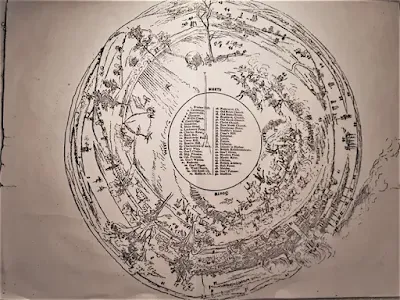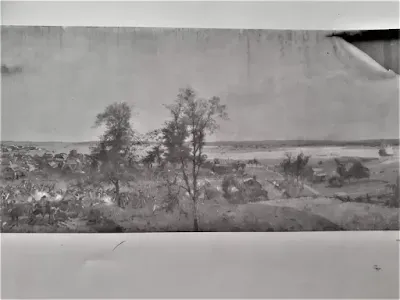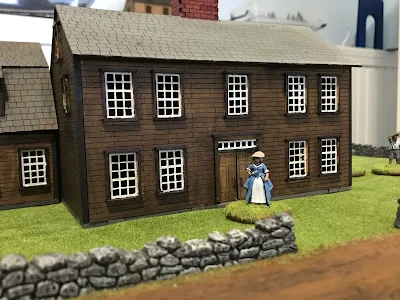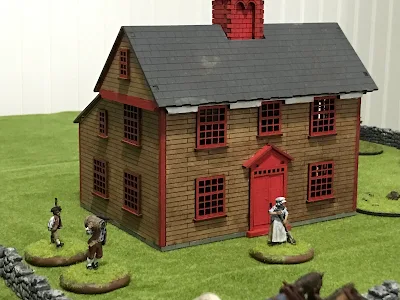A Popular entertainment in the late 19th century was the Cyclorama. These consisted of a painting displayed an circular structure that presented viewers with a 360-degree view. These paintings were hundreds of feet long and could cost $200,000, taking a team of artists a year and a half to complete. Historical events, especially famous battles quickly replaced rural and urban landscapes as popular topics. Cycloramas, like many other varieties of entertainment in the 1800s, often toured from city to city. Each locale displayed these paintings in massive cyclorama buildings,
For attendees, the experience began by entering the building through a narrow passageway. After climbing a central staircase, visitors emerged onto a viewing platform, encircled by the cyclorama. For visitors it was as if they had been transported back into the battle itself. Narrators, lighting, and musical instruments frequently heightened the drama. Three-dimensional objects or figures were often blended into the painted backdrop as well.
 |
| Gettysburg Cyclorama |
 |
| Boston Cyclorama building |
In 1880 Boston's Cyclorama Building displayed "The Battle of Gettysburg Cyclorama," painted by French artist Paul Dominique Philippoteaux. The building, located on Tremont Street in Boston's South End, still stands today, although it no longer displays monumental works of art.
A few years later in 1887, a second cyclorama building was built only two blocks away. This new structure (practically identical to the first cyclorama building) opened on February 5, 1888, displaying "The Battle of Bunker Hill Cyclorama."
 |
| B&W photo from original Cyclorama |
 |
| key to Cyclorama |
According to newspapers the Bunker Hill cyclorama's canvas measured 400 feet long and 50 feet tall, an alleged half an acre of painted surface. The cyclorama depicted the third and final British assault on the colonial fortifications on Breed's Hill from the perspective of the redoubt. The audience was virtually surrounded in the battle. To make sense of this all, visitors received a 16-page brochure describing the events of the battle, as well as a circular key annotating individual figures or locations within the painting.
"The Bunker Hill Cyclorama" was only displayed for two years. After 1890, other cycloramas depicting the life of Christ and the Battle of the Little Bighorn took its place. Ironically, as cycloramas reached their height of artistic accomplishment, they also quickly fell out of public favor. Much of the appeal derived from their novelty for first-time visitors, which did not bear up after repeated viewings. By the early 1900s, many cycloramas fell to neglect and disrepair. "The Battle of Bunker Hill Cyclorama" building itself was remodeled in 1895 and became the Castle Square Theater ( demolished in 1933). Lacking a suitable place to be displayed, the exact fate of the cyclorama painting after 1890 remains unknown.The Battle of Gettysburg Cyclorama" fortunately enjoyed a happier fate. It is currently located at Gettysburg National Military Park.


Later, nearly half a century since the "Battle of Bunker Hill Cyclorama" went missing, interest in it increased in 1943 when the Bostonian Society procured a set of black and white photograph of the original cyclorama. A reproduction of the lost cyclorama based on the negatives was considered. However, no such reproduction was ever undertaken. In 1982 I had copies of these photographs made and displayed as part of the new exhibits at the Bunker Hill Monument. Each plate was enlarged and place within the monument to show the view during the battle from that area.
In 1961, Clifford Smith donated three oil on canvas studies of "The Battle of Bunker Hill Cyclorama" to the Bostonian Society. These studies in 1883 were used as reference material when composing the full cyclorama.
Interest was reignited again in the 1960s and 1970s in re-creating the original cyclorama experience by exhibiting the three surviving studies. However, the studies were in no condition to be displayed. Without funding to restore them, the Bostonian Society stored them in the attic of the Old State House. The Society eventually loaned the studies to the National Park Service in the late 1980s with the intent of repairing them. The cost of refurbishing the paintings was substantial however, and the Park only restored one of the three paintings. Boston National Historical Park considered displaying this sole restored study at the Bunker Hill Museum when the museum opened in 2007.
.
Currently, the closest complete representation of the original cyclorama on display is a 360-degree mural displayed at the Bunker Hill Museum. Local artist John Coles painted this mural, and although not to the scale of the original cyclorama, it is nonetheless 80 feet long and four and a half feet tall. Like the original cyclorama, the mural positions the viewer in the center of the action at the redoubt. Coles worked on the mural in eleven separate sections in his studio before it was installed at the museum. From start to finish, the work took a year to complete.




.webp)


.jpg)































.webp)
.webp)

_kindlephoto-12028177.webp)
.webp)
.webp)
_kindlephoto-12105790.webp)
_kindlephoto-12076066.webp)

_kindlephoto-12044878.webp)


.webp)